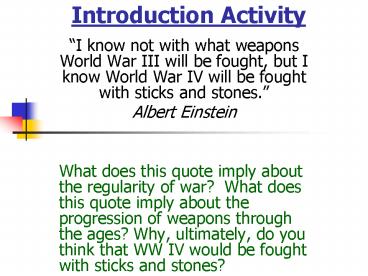Introduction Activity PowerPoint PPT Presentation
1 / 33
Title: Introduction Activity
1
Introduction Activity
- I know not with what weapons World War III will
be fought, but I know World War IV will be fought
with sticks and stones. - Albert Einstein
- What does this quote imply about the regularity
of war? What does this quote imply about the
progression of weapons through the ages? Why,
ultimately, do you think that WW IV would be
fought with sticks and stones?
2
Bolt-Action Rifle
- Bolt-action rifles could fire up to 15 rounds per
minute. - Rifles could hit targets up to 1,400 meters away.
3
Machine Gun
- A machine gun would need 4-6 men to operate it.
- A machine gun could fire up to 400 rounds per
minute.
4
(No Transcript)
5
Artillery
- Artillery refers to large-caliber, mounted field
guns. - The caliber of a gun refers to the diameter of
the barrel.
6
Artillery Shells
- Artillery could fire shells distances of up to
approx. 12,000 yards. - Artillery shells could weigh up to 900 lbs.
- It could take up to 12 men to handle an artillery
gun and load the shells.
7
(No Transcript)
8
Poisonous Gases
- Gases could cause choking, blistering, vomiting,
internal and external bleeding, blinding, a
burning of lung tissue, and ultimately, death. - Gases were lobbed into enemy trenches, killing or
disabling troops.
9
Poisonous Gases
- Gases were often colorless and odorless, and it
could take up to 12 hours for the gas to take
effect. - It could take up to 5 weeks to die from gas
poisoning. - Gas masks were eventually created to counter the
effects of gas attacks.
10
Zeppelins
- Otherwise known as blimps, zeppelins were
airships filled with hydrogen to keep them
afloat. - Zeppelins weighed up to 12 tons.
11
Zeppelins
- Zeppelins could travel at speeds of up to 136
mph. - Machine guns were usually mounted on the
airships, and they each carried over 4,000 lbs.
of bombs.
12
Tanks
- Tanks were armored vehicles that traveled on
tracks, allowing it to cross many kinds of land. - Tanks protected advancing troops across
no-mans land.
13
Tanks
- Early tanks needed a crew of about 3 men to
operate the navigation and guns. - The first tanks could travel up to 3 MPH.
- By the end of the war, tank crews had grown to 10
men, and tanks achieved speeds of up to 4 MPH.
14
Planes
- Planes were one- or two-seat propeller planes
equipped with a machine gun. - Planes where first used as observation tools
during battles. - Eventually bombs and cannons where added to the
planes. - Pilots engaged in dogfights in the air in order
to protect their men on the ground.
15
U-Boats
- Underwater ships that capable of launching
torpedoes, or guided underwater bombs. - Submarines ranged in length from about 200 feet
to more than 550 feet. Their rounded hulls were
about 30 feet in diameter. More than 150 crew
members can live and work in a large submarine.
16
Trench Warfare
17
- Trenches were elongated pits dug 6-8 ft. into the
earth, and stretching out over hundreds of miles. - Trenches were only wide enough to allow two men
to pass side-by-side.
18
(No Transcript)
19
(No Transcript)
20
(No Transcript)
21
Trench Warfare
- Duck Boards would line the bottom of the trench,
to serve both as a place for the men to stand on
the avoid enemy fire, and also to raise men above
the mud, rats, blood, and bodily wastes that
filled the bottom of the trench. - Parapets served as a rest for a gun, and the
Parados protected the men from exploding shrapnel
from behind the line.
22
Trench Warfare - Diagram
23
- Barbed-wire was lined up in front of a trench to
protect the men from attack.
24
Trench Warfare
- Dugouts in the side of the trenches provided
shelter for the men to live in, and protection
from incoming artillery fire.
25
The entrance to a dugout
26
Trench Warfare Dugout
27
Trench Warfare
- Three interlocking trench lines would be used a
front line for attack and defense, a middle line
of defense, and a rear line of reserves. An
encampment of tents and hospitals would be
located behind the third line. Men spent
anywhere from one day to two weeks on the lines
before given a day of rest.
28
(No Transcript)
29
- The distance between opposing trenches was called
no-mans land. This distance could be as short
as 30 meters, or as wide as 1 mile.
30
(No Transcript)
31
Trench Warfare
- On command, soldiers from a trench would charge
across no-mans land and attempt to overrun the
opponents trench. - Once one of the sides overran an opposing trench,
the defeated would either be captured, or they
would retreat to another set of trenches miles
away to renew the battle over a new no-mans
land.
32
A periscope would have been used to see the
enemy, without putting a soldier in the direct
line of fire.
33
Retrieving a dead soldier from no-mans
land

